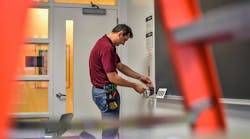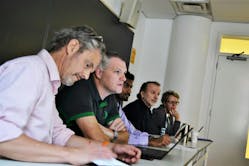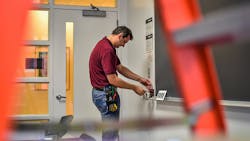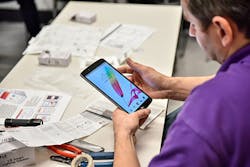Facility owners are making major investments in lighting controls because the intended results are so attractive: energy code compliance, important energy savings, and the benefits of advanced technology. But how well is the investment performing, and who has been trained to keep that expensive system in good working order?
The performance and resiliency of lighting control systems are critical for all involved: those who design the system, install and set it up, use it, and maintain its effectiveness. System performance also matters to owners who paid for the system and expect it to perform as intended. Problems that annoy occupants (such as misbehaving sensors) are often reported to facility personnel. In other cases, users may not recognize that something is wrong. And sometimes, there’s no problem — users simply don’t know that, for example, the lights can be dimmed, because the function isn’t clearly indicated on the control (Photo 1).
When lighting controls fail to meet expectations — and they do to a remarkable degree — it often turns out that users and facility personnel don’t know how to use the system and maintain it. Dissatisfaction blows back on all involved, with installing electrical contractors and facility/maintenance personnel usually taking the brunt of the blame. Waist-deep in problems, many facility personnel opt for a “solution” that lets them move on to the next emergency. With training and practice, however, many problems can be addressed more constructively. Training takes expertise, time, and commitment — not to mention money.
The Challenge: Training is Valuable But Not Free
To build a capable maintenance team, facility owners should insist on training regarding their lighting control systems and expect to pay for the time/expertise to plan and deliver this training. Contractors and suppliers can help by making customer-focused training a part of their proposals. With advanced controls, an investment in training for staff could pay for itself in short order.
Training is valuable but not free. Owners and managers may be less likely to permit staff to miss training if it’s clear that it’s been paid for.
Where to Start
The ideal providers for lighting control training are those who are both comfortable with the installed system(s) and experienced in communicating technical material to those who are not familiar with it.
Likely trainer candidates are those who set the system up. This might be a field technician from the manufacturer of the system or the organization that sold it. For complex projects, the system integrator would be a good choice. Nevertheless, it’s worth insisting on resources who possess both technical and training skills; you don’t want to train the trainers. Local electrical firms and sales agencies may be interested in maintaining a continuing relationship with facility owners, and their field techs typically have more flexibility in scheduling their time to assist with training.
Effective Training Starts at the Top
You have heard it before: In busy organizations, there’s never enough time for training; problems are addressed (or not) one at a time. Effective training requires commitment from the top. Senior facilities managers need to make the maintained performance of the lighting control system a priority, not just another line on the “to-do” list.
Identify the manager (or managers) responsible for training. Require a detailed training program, and make it realistic. Then follow up to see that the program is implemented and ongoing. Finally, measure the results, and hold those in charge accountable — for success as well as system failures. Faster times to successful resolution can assess training effectiveness better than the number of hours spent viewing videos or sitting in class.
Participants
True system resiliency depends on the ability of facilities personnel to anticipate problems and respond promptly and appropriately. Training a few staff members may result in an effective response to individual problems as they arise. What about the remainder of the staff, the press of other priorities, and unfamiliar contingencies? And what about access to resources and the ability to communicate clearly to contract specialists about system details and specific problems? Organized training addresses these issues and develops the foundation for maintaining a healthy lighting control system (Photo 2).
The operation of lighting control systems typically touches three parts of the organization: the electrical maintenance team, IT (which often “owns” some of the infrastructure), and front-line facilities leadership. Small organizations with limited staff may need to cross-train generalists. When using a maintenance contractor, it also makes sense to include system-specific training for anyone assigned to the facility.
Scheduling
Look for a time when facilities personnel are available and already have some familiarity with the system. Scheduling immediately after a new facility is turned over and opened may place training in direct conflict with the multitude of demands faced by maintenance staff trying to bring every building system online at the same time.
Program Content
Training program content depends, of course, on the system(s) installed and the experience and technical knowledge of facility personnel. For the more experienced, training might jump right into the installed system. Less experienced personnel may benefit from learning the manufacturer’s technical vocabulary to be able to understand technical documents.
Basic Training Outline
Troubleshooting as a discipline. Identifying problems in lighting control systems tends to be less intuitive than for other electrical systems. A good training program begins by instilling a step-by-step approach, documenting each system response, and developing the ability to communicate clearly about system conditions and problems (Photo 3).
System architecture. Facilities personnel should understand the principal components of the control system, what these components do, where they are located, and how they interconnect. The training program should explain how to read a controls single-line diagram and manufacturer’s operation and maintenance manuals. It might be helpful to include in-house IT personnel here.
Field-programmable components. Facilities personnel should know how to adjust settings, return to original and default settings, and — critically — what the desired settings are (and why). The sequence of operations (SOO) will typically reveal much about the system and provide continuing reference to original settings.
System interfaces. How well facility users interact with the control system can determine the level of satisfaction or complaint. Facility personnel, the “first responders” to problems, should be able to guide users in the operation of keypads and device override signals.
Wireless connectivity. Troubleshooting connections in a wireless control system is typically more challenging than diagnosing a wired system. Be sure the trainer has plenty of background for this topic.
From Everyday…
When occupancy sensors don’t operate as anticipated, disabling the device or extending its time-out period “solves” the problem — but it does so by wasting energy and money. Another common sensor issue involves incorrect installation that locates sensors behind doors or where they “see” only an occupant’s back and cannot detect smaller occupant movements of the hands or arms.
Training facility personnel about occupancy sensors — providing an understanding of sensor capabilities and limitations — would serve as a foundation during installation, and sensitivity could be studied and adjusted from the first day. Training can then equip the team to resolve common user complaints without disabling the cost-saving equipment. At the very least, a simple checklist of options from easy to more complicated is a helpful tool.
To Special Spaces…
Scene controls commonly found in conference rooms are another common area of complaint. Without clear instructions from the controls specifier (see EC&M’s September article on the sequence of operations), a field technician may simply apply default settings that rarely correspond to the appropriate light levels for the different activities in a conference or multi-purpose space.
Moreover, even correctly defined scene controls need to be changed over time.
The keypads for many control systems can be programmed without advanced technical knowledge. However, facilities personnel need to be trained in how to change the settings on the specific system that has been installed (Photo 4).
To Truly Complex…
Problems arising in a complex control system vary and may interact with one another. Lights don’t turn on or off when they should; color is inconsistent; lights flicker; wireless connections fail to respond. While the symptoms may be clear, the diagnosis often is not. What is the root problem? Are there multiple problems? Do they interact? Where in the system are the problems located?
Some system problems, such as those related to color changing, can exceed the capabilities of even a well-trained facilities staff. You have to recognize your limitations and, when needed, call on external resources, typically from the manufacturer or the system integrator.
Resources
An accurate, detailed, and comprehensive log of problems — compiled by the software or kept by hand — may be your most important maintenance resource. The log not only records problems, diagnoses, and solutions, but it also provides the data to support upgrades and preventive maintenance. Stressing the importance of the log and training new facility personnel to use it builds consistency and reliability in the information it contains.
In addition to the comprehensive operations and maintenance (O&M) manual and standard electrical and lighting drawings, the facilities staff needs the documents that describe the system, such as the SOO, which details the control settings and identifies connections between lighting and other building systems. If unfamiliar with the SOO, facilities staff need to be trained in how to read the information within it.
The Payoff
A lighting control system is an expensive investment. Properly designed, installed, and set up, controls save energy and money, create beneficial lighting conditions for occupants, and adjust to changes in conditions and use. But these benefits depend on maintaining the system in good working order throughout its life — and maintenance depends on trained facilities staff. As the system’s installing contractor or facility manager, follow these best practices to make it happen.








